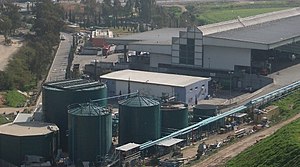Still working to recover. Please don't edit quite yet.
Biogas powerplant
| An article on this subject was deleted on Wikipedia: Wikipedia:Articles for deletion/ Biogas powerplant WP administrators can restore the edit history of this page upon request |
WP+ DEL |
A biogas powerplant is a system where Wikipedia:biogas is used to generate electricity. The gas which is produced via Wikipedia:anaerobic digestion is used to drive an Wikipedia:electricity generator. By-products of this process are steam and hot water. The hot water can be recycled in a combined heat and power cycle to increase the temperature of the digesters to optimal conditions.

Contents
Overview
Biogas power plants are a combination of anaerobic digestion systems with associated electricity generators such as Wikipedia:gas turbines or Wikipedia:gas engines. The electricity they produce is classified as Wikipedia:renewable or Wikipedia:green energy and if sold into the national grid may attract subsidies (such as Wikipedia:Renewables Obligation Certificates in the UK).
Feedstock into the biogas power plants must be biodegradable in order to produce methane. Suitable feedstocks include (but are not limited to):
- Wikipedia:Biodegradable waste
- Wikipedia:Sewage treatment Wikipedia:sludge (primary or raw sludge and/or secondary sludge)
- Wikipedia:Slaughterhouse waste
- Wikipedia:Food waste
- Wikipedia:Farm waste
- Organic component of mixed municipal waste (in Wikipedia:mechanical biological treatment)
- Biomass like Wikipedia:maize
There are three stages of anaerobic digestion: Wikipedia:hydrolysis, Wikipedia:acidogenesis, and Wikipedia:methanogenesis. These stages can occur in the same digestion tank or can be controlled independently and optimised according to the requirements of the different bacterial processes.
The more complex and efficient a biogas plant the more expensive it will be for the locality. Biogas plants can be simplified to produce gas for villages in countries where organic wastes are available and funds are limited. Alternatively, in more developed countries pressure in the form of legislation and high energy costs is increasing the amount of projects generating renewable energy from waste.
Biogas plants can be found in countries such as India (WP), China (WP), Philippines (WP), Germany (WP), Austria (WP) and Turkey (WP).
Advanced processing systems can recover the organic fraction mixed waste streams. These systems are a subgroup of mechanical biological treatment plants. They sort the recyclable elements of the waste and process the organic fraction into a high surface area low solids soup which are then passed into a biogas power plant (anaerobic digester). Advanced systems like this can be found in Israel.[1]. (ArrowBio) and Wikipedia:Australia and are being widely considered in Europe to meet the EU Wikipedia:Landfill Directive.
Further energy can be produced by the combustion of the Wikipedia:digestate which may be classified as a Wikipedia:biofuel.
Principal procedure
Biogas production
- 1 Preparing the biomass
- 2 Mixing
- 3 Digester/fermenter (Heating 40-90 °C)
Gas input
- 4 Raw biogas input 40 °C
- 5 Liquid gas Separator → condensates
- 6 Gas dryer (refrigerate) 4 °C → condensates
- 7 Wikipedia:Gas compressor about 400kPa
- 8 Gas filter (cleaning of dust particles, less than 5 parts per billion by mass of siloxanes)
- 9 Gas heating (minimum about 10 °C)
Gas combustion → thermal energy
- 10 Gas turbine exhaust output 300 to 400 °C
- 11 Generator → electric energy
Exhaust output → heat exchange
- 12 Wikipedia:HRSG heat recovery steam generation
- 13 Heat exchanger for hot water
Wikipedia:Siloxane might be present in the biogas and must be removed prior to input in the gas engines, as it erodes moving parts. Wikipedia:Hydrogen sulphide may also be produced in the process if there are high levels of Wikipedia:sulphur in the biogas. The exhaust gas must be cleaned up, as sulphur dioxide is toxic.
Plant engines
- Gas motor engines
- Micro–gas turbines
- Wikipedia:Fuel cells
- Wikipedia:Boiler
Plant types
Plant type depends on the type of biogas and usage of energy.
- Combined Heat and Power combined heat & power or HRSG
- Combined Heat, Cooling and Power production combined heat, cooling & power production (disambiguation page on Wikipedia)
Plant sizes
| Size | Power | Plant Size |
|---|---|---|
| Small | 500W to 5 kW | 10 m² |
| Medium | 5 kW to 75 kW | 15 to 100 m² |
| Large | 75 kW to 4MW | 1 km² |
The plant can also be segmented including Wikipedia:gas motors and Wikipedia:gas turbines.
See also
- Wikipedia:Anaerobic digestion
- Wikipedia:Biogas
- Wikipedia:List of waste management topics
- Wikipedia:List of waste treatment technologies
- Wikipedia:Mechanical biological treatment
- Wikipedia:Waste management
External links
- Video of Biogas Project at UC Davis
- Example of a Biogas from Waste Powerplant
- Carbon Financing to Develop Biogas Plant White Paper
- Bioturbine
- Biogas Plants from Germany
- Cornes AG Biogas Plant
- Low cost biodigester (Vietnam)
- Micro Turbine
- Plant types (Germany)
- 2G Bio-Energietechnik AG (Germany)
- 3 MW Plant (Philippines)
- Biogas power plant using Wikipedia:Maize
- Siya Instruments (India)
Education
References
- ↑ ArrowBio Process Finstein, M. S., Zadik, Y., Marshall, A. T. & Brody, D. (2004) The ArrowBio Process for Mixed Municipal Solid Waste – Responses to “Requests for Informationâ€, Proceedings for Biodegradable and Residual Waste Management, Proceedings. (Eds. E. K. Papadimitriou & E. I. Stentiford), Technology and Service Providers Forum, p. 407-413
Template:EnergyPortalTemplate:Sustainability and energy development groupTemplate:Waste